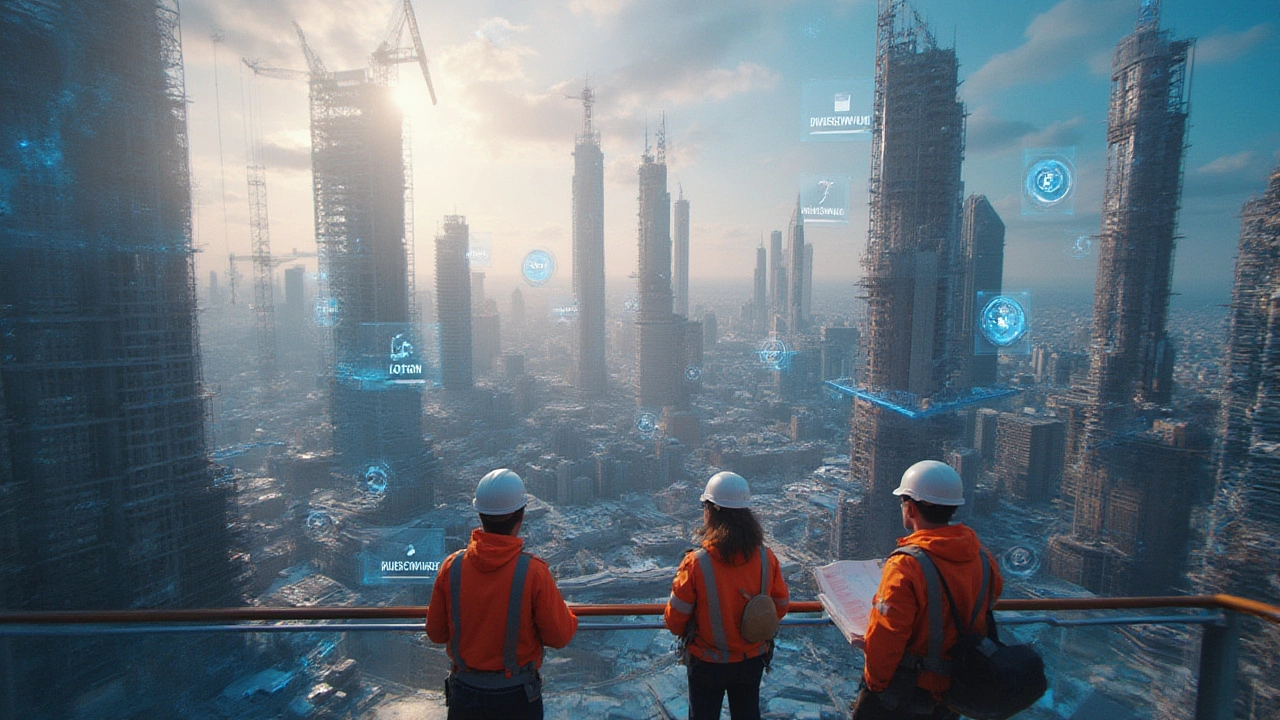If you think skyscrapers just pop up overnight or that billion-dollar bridges aren’t quietly changing how the world works, think again. The companies behind the tallest towers and longest tunnels run on tight schedules, fat contracts, and jaw-dropping project lists most of us can’t even imagine. The construction world is a high-stakes playground where billions move, competition is fierce, and finishing a week early is a victory. So, who leads this global race in 2025? Here’s the lowdown on the giants moving dirt, concrete, and dreams around the planet.
The Biggest Players: Meet the Titans
Every time you see a headline about a mile-high building in the Middle East or a city-sized factory in China, you can bet one of these companies is involved. It’s not just about size, either—diversity, innovation, and geography all play a role. By 2025, the balance of power has shifted east, but old names remain. Here’s a snapshot of the ten companies leading the charge:
| Company Name | HQ Location | 2024 Revenue (USD) | Notable Project |
|---|---|---|---|
| China State Construction Engineering Corporation (CSCEC) | Beijing, China | $300 Billion | The Beijing Daxing International Airport |
| China Railway Construction Corporation (CRCC) | Beijing, China | $160 Billion | Mombasa–Nairobi Standard Gauge Railway (Kenya) |
| Vinci | Nanterre, France | $65 Billion | Grand Paris Express Metro |
| ACS Group | Madrid, Spain | $43 Billion | Brenner Base Tunnel (Italy/Austria) |
| Hochtief | Essen, Germany | $31 Billion | Central Sydney Metro (Australia) |
| Skanska | Stockholm, Sweden | $20 Billion | LaGuardia Airport (USA) |
| Strabag | Vienna, Austria | $18 Billion | Vienna Central Railway Station |
| Bouygues Construction | Saint-Quentin-en-Yvelines, France | $16 Billion | Channel Tunnel (UK/France) |
| Bechtel | Reston, USA | $15 Billion | Crosstown Expressway (Canada) |
| Larsen & Toubro (L&T Construction) | Mumbai, India | $13 Billion | Hyderabad Metro Rail (India) |
China dominates the list, and it’s no accident. The world’s biggest population still fuels a building boom with megaprojects that stretch for miles. But don’t count out the European heavyweights, or the legacy American contractors who specialize in complex, high-stakes jobs. Every name here built its own legend by tackling projects that looked impossible on paper.
How These Companies Keep Winning
There’s more to being a construction giant than winning bids and pouring concrete. The leaders push innovation, juggle risk, and pull off logistical magic acts daily. They have armies of engineers, planners, and workers who can drop into a jungle or a city and turn chaos into rapid progress. Flexibility sets them apart—one year they’re raising a hospital, next they’re tunneling under oceans, or laying high-speed rail through mountains.
Dive into how they do it, and patterns pop up. First, they invest deep in tech—think AI-driven site planning, 3D-printed building components, and digital twins for real-time progress tracking. China State Construction, for example, has robots laying brick on some sites. Vinci’s digital management systems shave months off of project schedules. And with regulations getting tighter in Europe and North America, companies like Hochtief use smart sensors for green building verification—as much about paperwork as pollution these days.
Finance plays a wild card role. Most giants now bankroll their own projects or pull in deep-pocketed partners to weather economic storms. When Italy’s banks wobbled in 2023, ACS Group still broke ground in Spain and Canada, using lines of credit secured years ago. That sort of planning shocks the industry into respecting—or fearing—a company’s reach.
Then there’s talent. These companies train armies of their own. If you’re a hotshot engineer or project manager, CSCEC or Vinci recruiters might be sliding into your email inbox with offers to work on three continents in a single decade.
Iconic Projects That Changed Skylines
Some projects aren’t just expensive—they’re cultural landmarks. Look at the Burj Khalifa. CSCEC didn’t build it, but that tower fired a global arms race for record-breaking heights, luring giants from every continent to throw their hats in. Take Skanska’s work on LaGuardia’s new terminal in New York: decades in the making, it’s now a template for how to fix airports without melting down travel. And India’s Hyderabad Metro? That mega-project by L&T links millions in a notoriously chaotic city, showing that even the wildest traffic can be tamed with the right vision.
The Grand Paris Express, led by Vinci and Bouygues, is a 200 km metro system that’s rewriting the book for public transport. In Africa, CRCC slammed out the Mombasa to Nairobi railway in just 42 months—that’s nearly 500 km, through tough terrain, with all the political headaches Africa brings. In Austria and Italy, the Brenner Base Tunnel from ACS Group is set to be the world’s longest, slashing travel times under the Alps. These jobs aren’t just marvels—they change economies, reshape cities, and set a new bar for what construction can pull off at scale.
You want data? Estimated number of workers on CSCEC-reported active sites in 2024: nearly 400,000. Vinci, even leaner, manages 220,000 across 120 countries. These aren’t ordinary companies; they’re mobile populations driving innovation city to city.
The New Era: Sustainability and Tech Shake-Up
It’s not just about size any more. Today’s construction giants are quietly racing to get green. Europe, in particular, is writing tougher rules, but cash-rich clients in the US, the Middle East, and even China want low-carbon buildings and infrastructure too. That means greener steel, recycled concrete, even timber skyscrapers in a few leading cities. Hochtief’s central Sydney Metro use 100% renewable energy, which wasn’t heard of just five years ago. Vinci is pushing for net-zero on most new European sites before 2030.
Tech isn’t just a nice add-on now—it’s make-or-break. Building Information Modeling (BIM) is everywhere as the default, not the exception. Automated equipment, like Skanska’s driverless earthmovers or China Railway’s drone-guided survey tools, slice weeks off project timeframes. With cost overruns worse than weather, data analytics tools flag trouble well before it snowballs. One trick for budding construction pros: learn your way around digital project management, or you’ll get left behind.
Supply chain chaos hasn’t disappeared, either—2022’s global disruptions are a distant memory, but the lesson stuck. Giants like Strabag now source materials locally where they can, not just to lower emissions, but because waiting on a ship from a risky port can kill your bid. Don’t believe it? The new Olympic Aquatics Center in Paris finished early because Bouygues locked in their suppliers months before the competition even started bidding.

What Sets These Leaders Apart?
The top players look big and unstoppable, but what really lifts them up is hunger for risk and ability to adapt. They enter new markets, sometimes succeeding where local players can’t. L&T, for example, took home megaprojects in Africa and the Middle East by offering all-in-one packages—design, build, financing—crushing smaller competitors who can’t stretch that far. Bechtel’s edge is in complexity: most of their jobs involve wicked logistics and multi-country regulations. The older the challenge, the more they lean in.
Fastest to finish, not fastest to start. The game isn’t about being the first on site in 2025—it’s about being the fastest, safest, and most reliable to leave. Bonuses and penalties drive company culture more than ever. For client tips: If you’re negotiating with giants, get iron-clad agreements and penalty clauses. These companies will meet deadlines even if they have to fly in a thousand welders from around the globe, but only if you hold them to it.
The drive to diversify is everywhere. CSCEC and CRCC now do as much work overseas as at home. Vinci and ACS push into Australia, North America, and Africa as Europe’s future looks more regulated. And nearly everyone is building for governments as much as for corporations—infrastructure spending is still king, especially for roads, rail, and energy projects.
One handy insider tip: these companies love to snap up startups and tech firms. Whether it’s new robotic bricklayers or AI-powered safety platforms, if there’s a gadget or code that can cut costs, boost safety, and tick the sustainability box, they’re buying or licensing. Savvy young firms can partner with these big names for rocket-quick growth—if they stand out from the crowd.
Watching the construction industry in 2025 is like seeing Formula One racing: ruthless speed, crazy innovation, and risks everywhere you look. The difference? When these companies win, cities, countries, and billions of people get a fresh shot at a better life.




